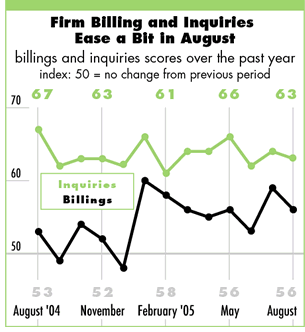

09/2005
Rebuilding after natural disasters typically occurs over a three-year or more timeframe

by
Kermit Baker, PhD, Hon. AIA
Chief Economist
 Heading into the aftermath of Hurricane Katrina,
architecture firms were reporting solid business conditions. Growth in
billings in August was somewhat below July rates, but above those reported
in June. The increase in inquiries was also down somewhat from the July
pace, but still at very healthy levels. Regionally, firms in the Midwest,
South, and West all reported healthy and improving billings. Firms in
the Northeast reported a modest decline in billings levels, their first
decline in almost two years.
Heading into the aftermath of Hurricane Katrina,
architecture firms were reporting solid business conditions. Growth in
billings in August was somewhat below July rates, but above those reported
in June. The increase in inquiries was also down somewhat from the July
pace, but still at very healthy levels. Regionally, firms in the Midwest,
South, and West all reported healthy and improving billings. Firms in
the Northeast reported a modest decline in billings levels, their first
decline in almost two years.
What about Katrina?
Although business conditions were generally positive through August,
the big question is the impact of Hurricane Katrina on the economy
moving forward. Economic losses are currently estimated at about $200
billion, although this number has been steadily rising, and is likely
to continue to rise in the weeks ahead. This would make Katrina the
most expensive natural disaster in the U.S. by a wide margin. Hurricane
Andrew, the current record holder, hit coastal Florida in 1992, and
ended up costing about $45 billion in today’s dollars.
Katrina’s impact on the GDP—which measures the current production of goods and services and not the loss of property and other forms of wealth—will not be as great. Currently, most economists feel that Katrina will take about a half-point (or about $30 billion) out of growth in the economy during the second half of the year as unemployment grows in the Gulf region and business activity diminishes, but put as much or more back into the economy in 2006. Because the economy was healthy before the hurricane, the chances of it tipping the economy into recession are quite small.

Consumer spending is likely to slow in September and early October, as households wait to see the impact of Katrina on the economy. Preliminary September readings on consumer’s concern with conditions by the University of Michigan were quite alarming, with both consumer sentiment and consumer expectations falling to levels we haven’t seen since 1992.
However, in addition to the immediate loss to the regional economy, Katrina has disrupted activity that will be felt nationally. The Gulf region supplies about 25 percent of U.S. oil production, about 10 percent of our oil refining capacity, and about 20 percent of our natural gas production. The run-up in gas prices right after Katrina hit showed the perceived importance of the Gulf region to the health of our domestic oil industry. Additionally, the port of New Orleans, along with other affected Gulf ports, handle $150 billion in cargo per year, or about 20 percent of all U.S. imports and exports.
The construction impact of Katrina will be felt in two waves. Repair activities aimed at stabilizing and shoring up affected homes and buildings will dominate efforts over the next few months, putting pressure on selected building products (e.g. roofing, plywood and OSB, wallboard, and dimensional lumber). Construction projects in the pipeline before Katrina hit will likely continue on their current pace for the most part, with some being accelerated so as to avoid the expected increase in materials costs and labor shortages that may develop when Katrina-related rebuilding begins next year. The second wave—when rebuilding begins in earnest—will last several years and likely will add pressure to construction costs through higher materials prices and greater demand for construction labor.
 Rebuilding after a disaster
Rebuilding after a disaster
The likely rebuilding phase after a natural disaster was the subject
of our question to our AIA Work-on-the-Boards panel this month. This
group was not asked to comment on the likely duration of rebuilding
after Katrina; rather, in their experience, the typical duration of
rebuilding after a natural disaster. Just over half of the respondents
felt the typical timeframe to be three years or less.
However, natural disasters do have a regional character. Firms in the West, where earthquakes are more common, generally estimated a longer time-frame for rebuilding. A quarter of the firms in this region reported that most rebuilding is not completed for five or more years. At the other extreme, almost half of the firms in the Northeast felt that most rebuilding after a natural disaster is completed within two years.
Copyright 2005 The American Institute of Architects.
All rights reserved. Home Page ![]()
![]()
 |
||
This month, Work-on-the-Boards survey participants are saying: • Huge increases in energy costs are now translating into
continued cost escalation in construction materials. No projects
have been cancelled yet; however, this remains a possibility. • We feel construction costs will rise due to fuel increases
as well as a shortage of building products due to the rebuilding
of the South. • Construction remains very active in the housing, support
retail, and recreational markets. Material availability, cost,
and finding a quality labor force continue to be issues. • A lot of inquiries are coming in, but very few are progressing
into viable projects.
|
||